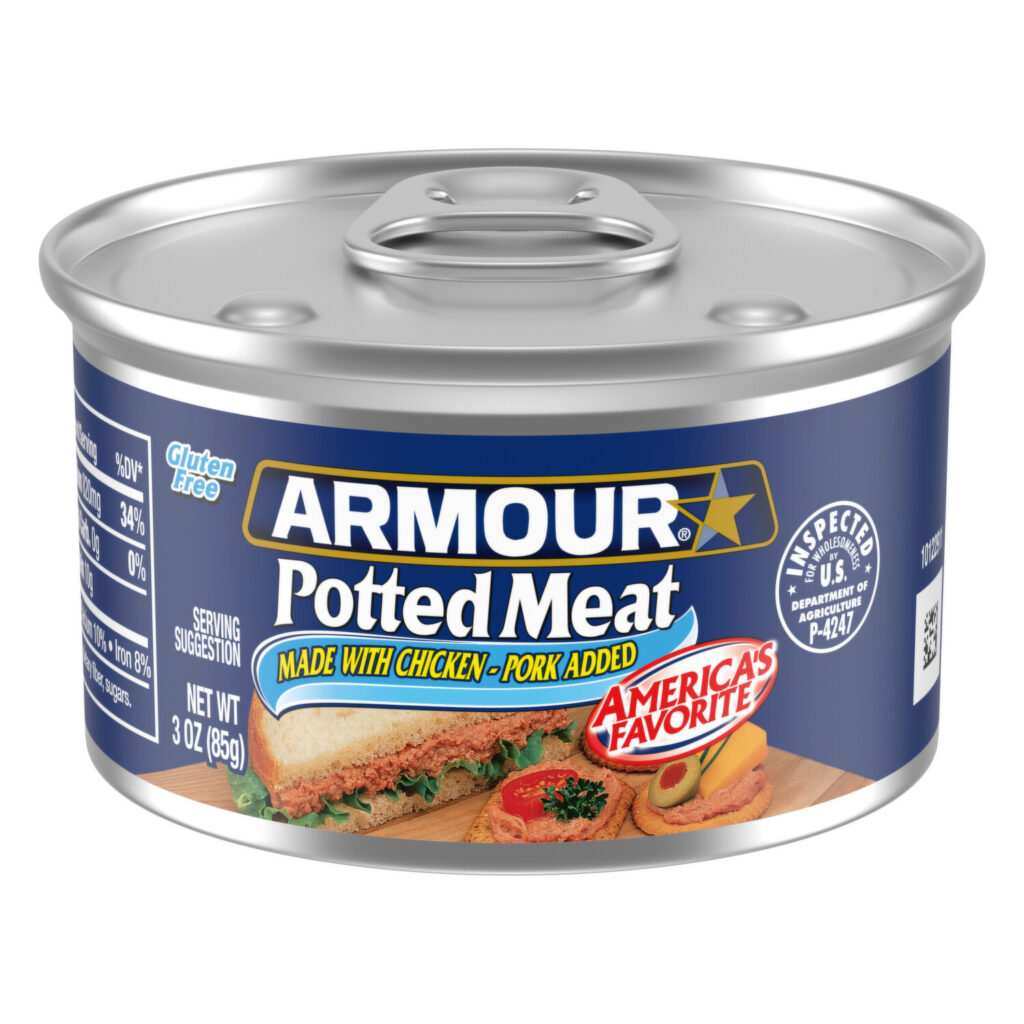What is Potted Meat?
Potted meat is a type of preserved meat product that involves cooking meat, seasoning it, and sealing it in a container with a layer of fat on top. This method of preservation creates an airtight seal, preventing spoilage and extending the shelf life of the meat. The result is a smooth, spreadable product that can be enjoyed in various ways.
Historical Background
The origins of potted meat can be traced back to ancient civilizations, where the need for food preservation was paramount. Before the advent of refrigeration, people needed methods to store meat for extended periods, especially during long journeys or in areas where fresh meat was scarce. The practice of potting meat allowed for the storage of protein-rich food that could withstand time without spoiling.Historically, potted meat was a staple for sailors and travelers. The sealed containers protected the meat from spoilage, making it a reliable source of nutrition. As refrigeration became more common in the 19th and 20th centuries, the popularity of potted meat declined, but it remains a beloved food item in many cultures today.
Preparation of Potted Meat
Ingredients
Potted meat can be made from various types of meat, including:
- Beef: Often used for its rich flavor.
- Pork: Commonly included for its fat content, which aids in preservation.
- Chicken: Frequently used for its mild flavor and accessibility.
- Combination of Meats: Some recipes utilize a mix of different meats to enhance flavor.
Cooking Process
The process of making potted meat typically involves the following steps:
- Cooking the Meat: The meat is first cooked until tender. This can be done through boiling, roasting, or braising.
- Seasoning: After cooking, the meat is seasoned with various spices, herbs, and flavorings to enhance its taste. Common seasonings include salt, pepper, garlic powder, onion powder, and vinegar.
- Blending: The cooked and seasoned meat is then blended or minced into a smooth paste. This creates a spreadable consistency that is easy to use.
- Sealing: The meat mixture is packed tightly into a container, often a small pot or jar, and covered with a layer of hot fat (such as lard or clarified butter). As the fat cools, it solidifies and forms an airtight seal, preserving the meat.
- Cooling and Storage: Once sealed, the potted meat is allowed to cool completely before being stored in a cool, dry place. Properly sealed potted meat can last for months or even years.
Commercial Products
Commercially prepared potted meat products are widely available in grocery stores. These products often contain a combination of meats, seasonings, and preservatives. Some popular brands include:
- Armour Star: Contains mechanically separated chicken, pork, and various seasonings.
- Hormel: Includes ingredients such as beef tripe and mechanically separated chicken.
- Great Value (Walmart): Features a blend of chicken and pork with seasonings.
These products are typically sold in small cans and are often used as convenient meal options or snacks.
Nutritional Aspects
Nutritional Value
Potted meat is a source of protein and essential nutrients, but it is also important to consider its nutritional content. Here are some key points regarding the nutritional value of potted meat:
- Protein: Potted meat is high in protein, making it a good option for adding protein to meals.
- Sodium: Many potted meat products contain high levels of sodium, which can contribute to health issues if consumed in excess. It is advisable to check labels for sodium content.
- Fat Content: The addition of fat in the preservation process contributes to the overall fat content of potted meat. While some fat is necessary for flavor and preservation, moderation is key.
- Preservatives: Commercial potted meat products often contain preservatives to extend shelf life. While these are generally safe, it is essential to be mindful of overall consumption.
Health Considerations
While potted meat can be a convenient food option, it is essential to consume it in moderation as part of a balanced diet. Here are some health considerations to keep in mind:
- Moderation: Due to its high sodium and fat content, it is best to enjoy potted meat as an occasional treat rather than a staple in the diet.
- Dietary Restrictions: Individuals with specific dietary restrictions, such as those on low-sodium diets, should be cautious when consuming potted meat.
- Storage and Safety: Proper storage is crucial to ensure the safety of potted meat. Always check expiration dates and ensure that the packaging is intact before consumption.
Uses of Potted Meat
Potted meat is a versatile food product that can be used in various culinary applications. Here are some common uses:
1. Spread
Potted meat is often spread on crackers, bread, or toast. It makes for a quick and easy snack or appetizer. The smooth texture allows it to be easily spreadable, making it a popular choice for gatherings and parties.
2. Ingredient
Potted meat can be used as an ingredient in various recipes. It can be added to casseroles, dips, and sandwiches to enhance flavor and provide protein. Its rich taste can complement a variety of dishes, making it a versatile addition to the kitchen.
3. Emergency Food
Due to its long shelf life and ease of storage, potted meat is often included in emergency food supplies or camping provisions. It provides a reliable source of protein that can be consumed without cooking.
4. Cultural Dishes
In some cultures, potted meat is considered a delicacy and is used in traditional dishes. It may be served alongside other foods or incorporated into recipes that highlight its unique flavor.
Cultural Significance
Potted meat holds cultural significance in various regions around the world. Here are some examples:
1. United Kingdom
In the UK, potted meat has a long history and is often associated with traditional British cuisine. It is commonly served as a spread on bread or toast and is enjoyed as part of a classic British breakfast or tea.
2. United States
In the United States, potted meat is often viewed as a convenience food. It is popular in rural areas and among campers and hikers due to its portability and long shelf life. Brands like Armour and Hormel have made potted meat a staple in many households.
3. Other Cultures
Various cultures have their own versions of potted meat, often incorporating local flavors and ingredients. For example, in some Mediterranean countries, similar preservation methods are used for fish and seafood, resulting in products like potted shrimp.
Table of Key Information
| Aspect | Details |
|---|---|
| Definition | Preserved meat sealed in fat for long shelf life |
| Historical Use | Preservation method before refrigeration |
| Common Ingredients | Beef, pork, chicken, seasonings, fat |
| Nutritional Value | High in protein, but also high in sodium and fat |
| Common Uses | Spread, ingredient in recipes, emergency food |
| Cultural Significance | Popular in the UK and US, variations in other cultures |
For more information about potted meat, you can refer to the Wikipedia page on potted meat: Potted Meat.
FAQ Section
1. What is potted meat?
Potted meat is a preserved meat product made by cooking and seasoning meat, then sealing it in a container with a layer of fat.
2. How is potted meat prepared?
The preparation involves cooking the meat, seasoning it, blending it into a paste, and sealing it with fat to preserve it.
3. What types of meat are used in potted meat?
Common meats used include beef, pork, chicken, and sometimes fish.
4. What are the nutritional benefits of potted meat?
Potted meat is a good source of protein but can be high in sodium and fat.
5. How is potted meat typically used?
It is often used as a spread on crackers or bread, as an ingredient in recipes, or as emergency food.
6. Is potted meat safe to eat?
Yes, when stored and handled properly, potted meat is safe to eat. Always check expiration dates.
7. Can potted meat be frozen?
Yes, potted meat can be frozen to extend its shelf life.
8. What are some popular brands of potted meat?
Popular brands include Armour, Hormel, and Great Value.
9. How long does potted meat last?
When sealed and stored properly, potted meat can last for several months or even years.
10. Is potted meat a healthy food option?
While it can be a convenient source of protein, it should be consumed in moderation due to its sodium and fat content.



